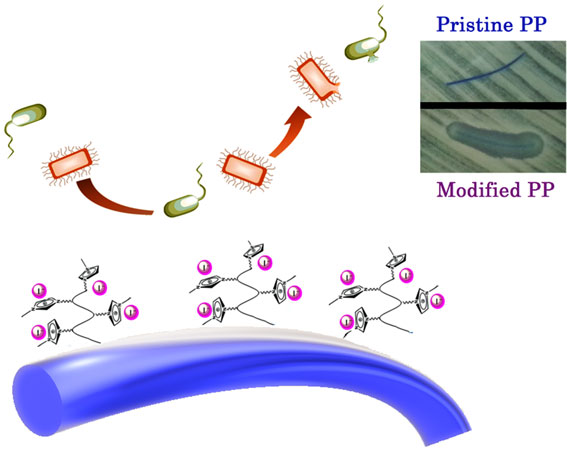Crossref Citations
This article has been cited by the following publications. This list is generated based on data provided by
Crossref.
Flores-Rojas, G. G.
López-Saucedo, F.
López-Barriguete, J. E.
Isoshima, T.
Luna-Straffon, M.
and
Bucio, E.
2018.
Polypropylene films modified by grafting-from of ethylene glycol dimethacrylate/glycidyl methacrylate using γ-rays and antimicrobial biofunctionalization by Schiff bases.
MRS Communications,
Vol. 8,
Issue. 1,
p.
168.
Ramos‐Ballesteros, Alejandro
Pino‐Ramos, Victor H.
López‐Saucedo, Felipe
Flores‐Rojas, Guadalupe G.
and
Bucio, Emilio
2019.
Surface Modification of Polymers.
p.
185.
Shitanda, Isao
Kato, Takanao
Suzuki, Ryo
Aikawa, Tatsuo
Hoshi, Yoshinao
Itagaki, Masayuki
and
Tsujimura, Seiya
2020.
Stable Immobilization of Enzyme on Pendant Glycidyl Group-Modified Mesoporous Carbon by Graft Polymerization of Poly(glycidyl methacrylate).
Bulletin of the Chemical Society of Japan,
Vol. 93,
Issue. 1,
p.
32.
Flores-Rojas, G.G.
López-Saucedo, F.
and
Bucio, E.
2020.
Gamma-irradiation applied in the synthesis of metallic and organic nanoparticles: A short review.
Radiation Physics and Chemistry,
Vol. 169,
Issue. ,
p.
107962.
Velazco‐Medel, Marlene A.
Camacho‐Cruz, Luis A.
and
Bucio, Emilio
2020.
Modification of relevant polymeric materials for medical applications and devices.
MEDICAL DEVICES & SENSORS,
Vol. 3,
Issue. 6,
Camacho-Cruz, L. A.
Velazco-Medel, M. A.
Cruz-Gómez, A.
and
Bucio, E.
2021.
Advanced Antimicrobial Materials and Applications.
p.
1.
Houshyar, Shadi
Bhattacharyya, Amitava
Khalid, Asma
Rifai, Aaqil
Dekiwadia, Chaitali
Kumar, G. Sathish
Tran, Phong A.
and
Fox, Kate
2021.
Multifunctional Sutures with Temperature Sensing and Infection Control.
Macromolecular Bioscience,
Vol. 21,
Issue. 3,
Velazco‐Medel, Marlene Alejandra
Camacho‐Cruz, Luis Alberto
Lugo‐González, José Carlos
and
Bucio, Emilio
2021.
Antifungal polymers for medical applications.
MEDICAL DEVICES & SENSORS,
Vol. 4,
Issue. 1,
Nasef, Mohamed Mahmoud
Gupta, Bhuvanesh
Shameli, Kamyar
Verma, Chetna
Ali, Roshafima Rasit
and
Ting, Teo Ming
2021.
Engineered Bioactive Polymeric Surfaces by Radiation Induced Graft Copolymerization: Strategies and Applications.
Polymers,
Vol. 13,
Issue. 18,
p.
3102.
López-Saucedo, Felipe
López-Barriguete, Jesús Eduardo
Flores-Rojas, Guadalupe Gabriel
Gómez-Dorantes, Sharemy
and
Bucio, Emilio
2021.
Polypropylene Graft Poly(methyl methacrylate) Graft Poly(N-vinylimidazole) as a Smart Material for pH-Controlled Drug Delivery.
International Journal of Molecular Sciences,
Vol. 23,
Issue. 1,
p.
304.
Yusefi, Mostafa
Nasef, Mohamed Mahmoud
Tareq, Mohammad Ali
Gupta, Bhuvanesh
Shameli, Kamyar
Ali, Roshafima Rasit
Ting, Teo Ming
and
El Enshasy, Hesham Ali
2022.
Bibliometrics of Functional Polymeric Biomaterials with Bioactive Properties Prepared by Radiation-Induced Graft Copolymerisation: A Review.
Polymers,
Vol. 14,
Issue. 22,
p.
4831.
Fontana‐Escartín, Adrián
Hauadi, Karima El
Lanzalaco, Sonia
Pérez‐Madrigal, Maria M.
Armelin, Elaine
Turon, Pau
and
Alemán, Carlos
2023.
Smart Design of Sensor‐Coated Surgical Sutures for Bacterial Infection Monitoring.
Macromolecular Bioscience,
Vol. 23,
Issue. 9,
Shitanda, Isao
Loew, Noya
and
Tsujimura, Seiya
2024.
Wearable Biosensing in Medicine and Healthcare.
p.
379.
Flores-Rojas, G.G.
López-Saucedo, F.
Vázquez, E.
Vera-Graziano, R.
Buendía-González, L.
Mendizábal, E.
and
Bucio, E.
2025.
Antimicrobial Materials and Coatings.
p.
177.
Flores-García, Luis A.
López-Saucedo, Felipe
and
Bucio, Emilio
2026.
One-step gamma radiation-induced grafting of poly(N-vinylcaprolactam) and poly(methacrylic acid) onto polypropylene suture threads.
Radiation Physics and Chemistry,
Vol. 239,
Issue. ,
p.
113279.



